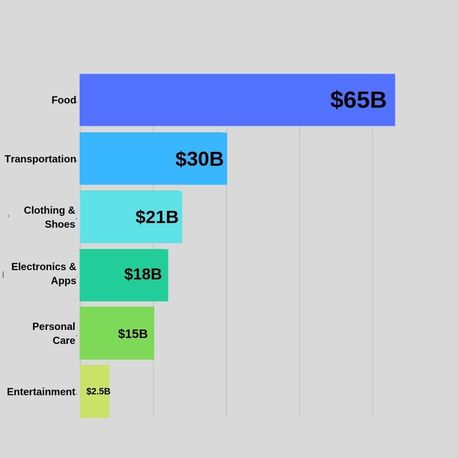Going to college is an important social rite of passage for many young adults. No longer living under their parents’ wings for usually the first time, college students are truly presented an opportunity to independently explore newfound interests and social interactions. As a result, they start understanding themselves and who they really are. This is why college marketing is so difficult but essential to the success of a business.
Part of this discovery process entails having an open mind that is readily influenced by outside occurrences. They are willing to try and experience new things to see what they like and don’t like. Herein lies a huge opportunity for marketers. By positioning their brands early and often, they can gain a piece of the student’s mind. Over time, this affinity grows stronger, usually translating to a purchase of the product or service at some point down the road.
What College Students are spending NOW
There is a widespread perception that students are broke, which is not quite true. Looking into the data, college students, as a group that is 19.9 million strong, have an enormous spending potential of $574 billion. Of this amount, a cool $212B is spent towards “discretionary” purchases, including everything from food to personal care and entertainment (Image 1). Sure, students are very careful with how they spend their money, but given the sheer size of the market, it is well worth it for marketing teams to have an active presence on campus.

Image 1: College Discretionary Spending by Category
A certain “event” of particular importance when it comes to college marketing is back-to-school. During the months of July-September, students front-load a majority of their purchases in advance of the new school year. In fact, $55.3B was spent on back-to-school shopping alone in 2018, with that number expected to rise for 2019. Once again, the categories of purchases varies from items like electronics to school supplies (Image 2). It is important to have a presence in college year-round, but especially during the crucial back-to-school shopping months when students are spending the most.

Image 2: College Student Back-to-school Spending by Category (per average)
The Residual Effects of College Marketing
However, the current spending habits of college students is only half the story. Once they develop their affinities to certain products and services, college students tend to be very brand-loyal, as 66% say that once they find a brand they like they will continue to buy for a long time. If a brand gets a piece of the student mind-share early, they can expect a high lifetime customer value — especially once these students start a career and have even more to spend. On average, students who graduate with a bachelor’s degree will earn $2.1 million over their lifetime. Furthermore, they have $1 million more to spend during their lifetimeswhen compared to their high school graduate peers. This earning potential, coupled with the fact that they form their brand preferences for the first time in their adult lives, makes it crucial to market to them at the forefront of their initial purchasing decisions.
That all being said, it is important for brands to not underestimate the challenges of making those initial impressions. The college market is a highly particular audience where immediate returns are not always warranted. Besides the fact that mirroring traditional advertising techniques doesn’t work, college students have close to a 10-year customer lifecycle journey. Brands have to provide students a positive experience on numerous occasions before the student ultimately makes that first purchasing decision. Therefore, it is important to develop a multi-faceted marketing approach that gently nurtures this audience to conversion.
An example marketing initiative that tends to leave a highly personable experience is developing a campus ambassador program, which is what we at Evolvez specialize in. Brands employ college students who are already passionate brand champions to spread their message, product, or service on campus. This way, the brand messaging becomes more organic and readily acceptable since a friend is telling another friend about it. At the end of the day, who better to communicate the brand message to students than the students themselves?
